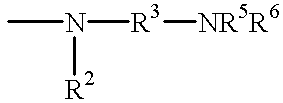Enzymes and micro organisms with amidase activity which hydrolyze polyamides
a technology of amidase activity and enzyme, applied in the field of biomedical materials research, can solve the problems of insufficient hydrolysis to be exploited on the industrial scale, and relatively low specific activity towards oligomers
- Summary
- Abstract
- Description
- Claims
- Application Information
AI Technical Summary
Problems solved by technology
Method used
Image
Examples
example 1
AND IDENTIFICATION OF THE WILD-TYPE STRAIN COMAMONAS ACIDOVORANS N 12
1.1 MICROBIOLOGICAL SCREENING
A vast microbiological screening operation enabled the strain Comamonas acidovorans N 12 to be selected from various biotopes.
1.2 SELECTION-IDENTIFICATION OF THIS MICROORGANISM:
This microorganism was selected with the aid of an amidase activity test on synthetic oligomers of PA 6.6. The evaluation of activity will be given in detail below.
The selected microorganism was then identified on the basis of its morphological, physiological, biochemical and possibly antigenic properties, in completely traditional manner, by the Bacteriology Laboratory of the INSTITUT PASTEUR.
On the basis of these results and the hydrolytic activities on a mixture of oligomers AB, ABA, BAB and ABAB, the natural strain selected was then subjected to a more thorough characterization.
example 2
CHARACTERIZATION OF COMAMONAS ACIDOVORANS N 12
2.1 OPTIMIZATION OF THE CULTURE CONDITIONS:
The optimum culture medium is M9YE3 having the following composition:
and supplemented with 10 g / l of adipic acid salt.
The cultures are prepared in Erlenmeyer flasks filled to 1 / 5 of their total volume. The media are incubated at 30.degree. C. and stirred at 150 rpm.
The preculture is composed of 10 ml of LB medium:
inoculated with a colony originating from a Petri dish containing M9YE3 agar medium and 5 g / l of a compound containing an amide group, such as pentameric to decameric oligomers of PA 6.6.
The culture is then inoculated at 1% with the optimum medium (v / v). When culture is complete, the cell production is determined via a dry extract obtained by the drying, overnight at 105.degree. C., of a cell residue obtained after centrifugation (10 min at 12,000 g)
To obtain maximum efficacy in the hydrolysis, a compound containing at least one amide group is advantageously introduced into the medium.
A...
example 3
ION OF THE POLYAMIDE HYDROLASE OF COMAMONAS ACIDOVORANS N 12 ACCORDING TO THE INVENTION
The activity of this enzyme (PAM II) is monitored by determining the activity in the hydrolysis of ABAB to BAB+A.
3.1 GLOSSARY:
3.2 PREPARATION OF THE ENZYMATIC EXTRACTS:
The starting material consists of cells originating from a 20-hour culture in a 2.5 I flask filled with 500 ml of M9YE3 medium described in Example 2, supplemented with 10 g / l of adipic acid salt.
FIRST EXTRACTION BY ULTRASONIC TREATMENT:
25 g of Comamonas acidovorans cells are resuspended in 75 ml of 100 mM Tris-HCl buffer, pH 7.5, containing 1 mM DTE, 5 mM EDTA, 100 mM KCl and 15% v / v of glycerol.
The suspension is then subjected to a discontinuous ultrasonic treatment (10% treatment, 90% rest) in melting ice for 70 min.
The suspension is then centrifuged for 1 h 30 min at 50,000 g (Beckman ultracentrifuge).
This finally gives:
.fwdarw. on the one hand 90 ml of supernatant (S1) containing 21 mg / ml of proteins, i.e. 189...
PUM
| Property | Measurement | Unit |
|---|---|---|
| pH | aaaaa | aaaaa |
| v/v | aaaaa | aaaaa |
| volume | aaaaa | aaaaa |
Abstract
Description
Claims
Application Information
 Login to View More
Login to View More - R&D
- Intellectual Property
- Life Sciences
- Materials
- Tech Scout
- Unparalleled Data Quality
- Higher Quality Content
- 60% Fewer Hallucinations
Browse by: Latest US Patents, China's latest patents, Technical Efficacy Thesaurus, Application Domain, Technology Topic, Popular Technical Reports.
© 2025 PatSnap. All rights reserved.Legal|Privacy policy|Modern Slavery Act Transparency Statement|Sitemap|About US| Contact US: help@patsnap.com



